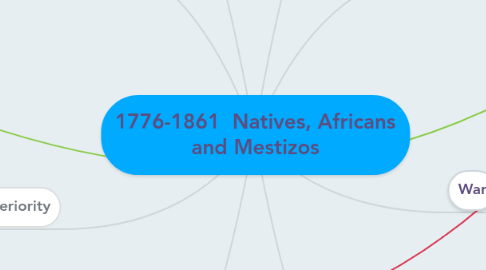1776-1861 Natives, Africans and Mestizos
por Nancy R.

1. Physical Distinctions
1.1. Jefferson states that the difference in skin color is fixed in nature. other physical distinctions proving different races is hair, body figures, have a strong ordor, and are more tolerant of the heat than whtes.
1.2. The dehumanization and brutal treatment of whites towards other races including natives, Africans, and other non-European origin
2. Policies/laws
2.1. The Cherokee used legal means in their attempt to protect their rights. In 1827, the Cherokee adopted a written constitution declaring themselves to be a sovereign nation which at first was denied and when it was finally approved. Jackson did not enforce the laws.
2.2. From 1814 to 1824, Jackson negotiated 9 out of 11 treaties which divested the sothern tribes of their eastern lands in exchange for lands in the west. Tribes agreed to the treaties for strategic reasons.
2.3. The Indian Removal
2.4. Treaty of Guadalupe Hidalgo
3. Inferiority
3.1. America's Manifest destiny purposes excluded native Americans and non-European origin because they were seen as incapable of self government.
3.2. According to Jefferson, in memory blacks are equal to whites but in reason are much inferior.
3.3. In 1823 the supreme court ruled down a decision stating that Indians could occupy land within the U.S. , but could not hold titles to those lands.
3.4. The Indian Nations in the view of settlers and many other white Americans, were standing in the way of progress.
3.4.1. "All proceeding experiments for the improvement of the Indians have failed. It seems now to be an established fact that they cannot
3.5. The slave trade
4. Resistance
4.1. Emancipation of African Americans: freedom
4.2. "Although the five Indian nations had made earlier attempts at resistance, many of their strategies were non-violent"
4.3. Retaliation: some Indians began stealing livestock, and crops from white settlers. Some even arson and murder.
4.4. Despite their hardships, slaves managed to develop a strong cultural identity and maintained strong family ties.
4.5. Slaves frequently altered the lyrics of spirituals to carry hope of freedom or to celebrate resistance.
5. Religion
5.1. Catholism was and still is a fusion of multiple elements including European, different indigenous cultures, and African.
5.2. Mexico's Catholic Church was unable to exercise authority in the border areas.
5.3. Slaves introduced to Christianity developed their own forms of worship. "The music of worship expressed both slave endurance and religious belief."
6. Manifest Destiny: Continental expansion
6.1. The U.S.-Mexican War was about territory and continental expansion, access and ownership of all minerals and riches. the war was about profit for some groups.
6.2. It was a national destiny for Americans,. they felt it was their mission to extend their boundaries to others who were capable of self government.
6.3. As a result of the treaties, the U.S. gained control over three-quarters of Alabama,, Florida, as well as parts of Georgia. Tennessee, Mississippi, and North Carolina.
7. War
7.1. U.S. population grew, thus there was a need for expansion into new territories.
7.2. "Andrew Jackson, from Tennessee, was a forceful proponent of indian removal. in 1814 he commanded the U..S. military forces that defeated a faction of the creek nation."- Indian Removal
7.3. Some Indian nations refused to leave their land and were willing to wage war to protect their lands.
7.4. The war was about increasing the slave population, and was also about language, culture, race and religion.
8. History
8.1. One method of strategies the Indian nations went for was adopting to Anglo-American practices such as large-scale farming.
8.2. Trail of Tears: thousands of Indians were forced out of their homes which were looted by whites. They began the march where many died of cold hunger, and disease on their way to western lands.
8.3. "Historical experience since the 19th century has been an effort to erase our language across time. The land we still don't own for the most part."
8.4. "we're all interconnected, and this, this nation, this country could not be what it is with out all of us."- The Consequences of Conquest
8.5. the U.S.-Mexican war shaped the area in which many of us live today.


